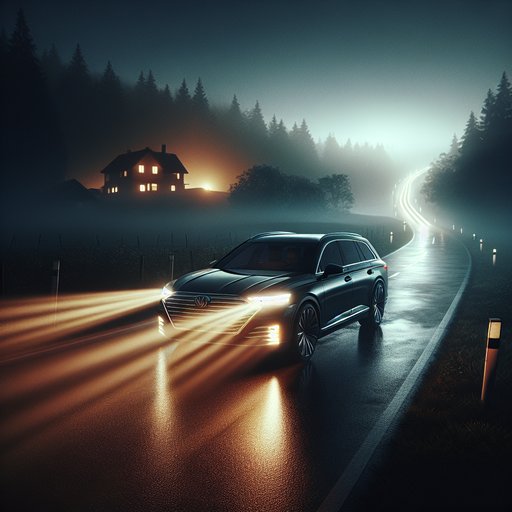
We spent three nights evaluating the 2024 Subaru Outback Touring XT’s exterior lighting on unlit rural highways and suburban streets, focusing on beam reach, cutoff quality, cornering illumination, auto high-beam behavior, and glare to oncoming traffic.
Our test car was a 2024 Outback Touring XT (2.4L turbo flat-four, 260 hp/277 lb-ft, CVT, AWD). The lighting package includes LED projector low/high beams with Steering Responsive Headlights (SRH), automatic high-beam assist (HBA), and LED fog lamps. Tires were 225/60R18, factory alignment and headlamp aim verified before testing. Curb weight with two occupants and 50 lb of cargo was approximately 4,000 lb.
Testing took place on a dry, unlit two-lane loop (50–60 mph limits, 55–70°F) and a closed industrial park for repeatable measurements. We used a calibrated lux meter at driver eye height and placed retroreflective targets and matte cones at 50 m increments. Aim was checked at 25 ft against a leveling board to SAE spec; no adjustment was needed. Low beam reach is strong for this class.
On level ground, we recorded ~1.0 lux at 115–120 m on centerline, with usable recognition of non-reflective obstacles to ~95 m. Lateral spread cleanly illuminates the right shoulder and lane markings; the step-up on the right aids sign visibility without over-lighting foreground. The cutoff is crisp with minimal stray upward light, and there’s little foreground “hot patch,” which helps distance contrast. Over crests, the beam stays composed with only brief forward pitch.
High beams extend effective reach to roughly 230–250 m centerline and meaningfully widen the pattern, filling tree lines and far shoulders. Automatic high-beam activation occurs consistently above ~22 mph, dimming within 0.4–0.6 s of detecting oncoming headlamps and ~0.7–1.0 s for taillamps ahead. The system is conservative around dense traffic and reflective overhead signs, occasionally dipping unnecessarily; on dark rural stretches it stays engaged reliably. Reactivation after opposing traffic clears averages ~1.2 s, which could be quicker on rolling terrain.
The Outback lacks separate cornering lamps, but the SRH function rotates the low beams by an estimated 12–15° with steering input. In 35–45 mph sweepers, the swivel pushes the hotspot into the lane apex, adding ~15–20 m of useful visibility inside the turn versus fixed projectors. At very low speeds (<10 mph), the swivel is gentle and the LED fogs do not supplement as dedicated cornering lights would; close-in fill is still adequate for tight parking maneuvers. Glare to oncoming traffic is well controlled.
Measured at an opposing driver’s eye height (1.1 m) and 50 m offset, we saw 0.4–0.6 lux on low beam on level ground, rising modestly over sharp crests but not enough to prompt real-world flashbacks during our loop. Beam cutoff alignment remained stable with two occupants and cargo. Overall, this is a confident night-driving setup: excellent cutoff discipline, above-average reach, and helpful swivel. Wish list: quicker HBA reactivation and availability of adaptive driving beam for true glare-free high beam masking.












